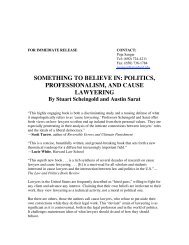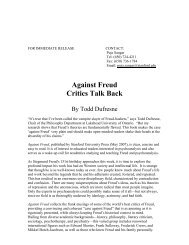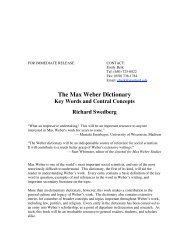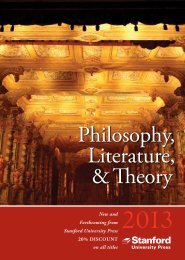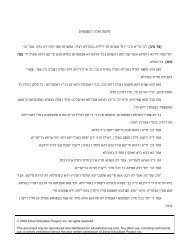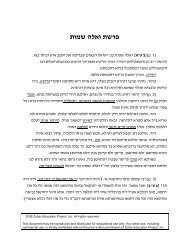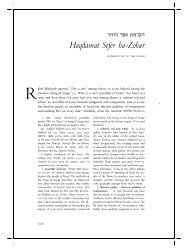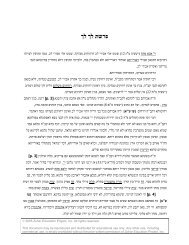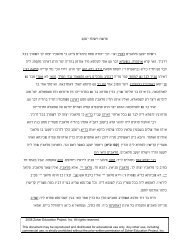Front Matter (PDF) - Stanford University Press
Front Matter (PDF) - Stanford University Press
Front Matter (PDF) - Stanford University Press
You also want an ePaper? Increase the reach of your titles
YUMPU automatically turns print PDFs into web optimized ePapers that Google loves.
term applied to this emerging school of mystical thought in the early thirteenth<br />
a<br />
century. The word means ``tradition''; its use in this context indicates<br />
the kabbalists saw themselves as a conservative element within the Jewish<br />
that<br />
community. Their secretsÐso they claimedÐwere qabbalah, esoteric<br />
religious<br />
received from ancient masters by means of faithful oral transmission<br />
teachings<br />
one generation to the next.<br />
from<br />
ProvencËal Jewish community in the twelfth century was one of great<br />
The<br />
wealth, formingsomethingof a bridge between the spiritual legacy of<br />
cultural<br />
creativity in Spain of Muslim times and the rather separate world of<br />
Jewish<br />
in the Ashkenazic or Franco-Rhenish area. It is in this cultural realm that<br />
Jewry<br />
®rst appears, about the middle of the twelfth century. The origins of<br />
Kabbalah<br />
spiritual and literary movement are obscure and still much debated. There<br />
this<br />
clearly elements of Near Eastern origin in the earliest Kabbalah, materials<br />
are<br />
to Merkavah and late midrashic texts that were present in the Holy<br />
related<br />
in the ninth or tenth centuries. There are also strongin¯uences of<br />
Land<br />
that were to appear in Rhineland Hasidism as well, indicatingthat<br />
elements<br />
some early point these two movements had a common origin. But here in<br />
at<br />
a new sort of religious discourse began to emerge in circles of<br />
Provence,<br />
who combined knowledge of these various traditions. These groups,<br />
mystics<br />
may have been several generations in formation, are known to us as the<br />
which<br />
as one of the strangest and most fascinating documents in the long<br />
editors<br />
of Hebrew literature. This slim volume is known as Sefer ha-Bahir,<br />
history<br />
renderable as The Book of Clarity. We ®rst ®nd reference to it in<br />
awkwardly<br />
works of the latter twelfth century, and from that time forward it<br />
ProvencËal<br />
a continuous history as a major shaper of Jewish mystical ideas.<br />
has<br />
Bahir takes the form of ancient rabbinic Midrash, expoundingon<br />
The<br />
phrases, tyingone verse of Scripture to another, and constructingunits<br />
biblical<br />
its own thought around what it offers as scriptural exegesis. Like the old<br />
of<br />
it makes frequent use of parables, showingspecial fondness for those<br />
Midrash,<br />
and their courts, in which God is repeatedly compared to ``a<br />
involvingkings<br />
¯esh and blood.'' In form, then, the Bahir is quite traditional. But as<br />
kingof<br />
as the reader opens its pages to look at the content, astonishment takes<br />
soon<br />
The text simply does not work as Midrash. Questions are asked and not<br />
over.<br />
or answered in a way that only adds mysti®cation. Images are<br />
answered,<br />
that in the midrashic context surely refer to God, and then suddenly<br />
proposed<br />
are said that make such a reading theologically impossible (The ``King''<br />
things<br />
out to have an older brother, for example). What sort of questions are<br />
turns<br />
and what sort of answers? The scholar is sometimes tempted to emend<br />
these,<br />
text! the<br />
one comes to the Bahir, on the other hand, bearingsome familiarity with<br />
If<br />
methods of mystical teachers, particularly in the Orient, the text may seem<br />
the<br />
bizarre. Despite its title, the purpose of the book is precisely to mystify<br />
less<br />
Introduction<br />
xxxiv<br />
rather than to make anything``clear'' in the ordinary sense. Here the way to



